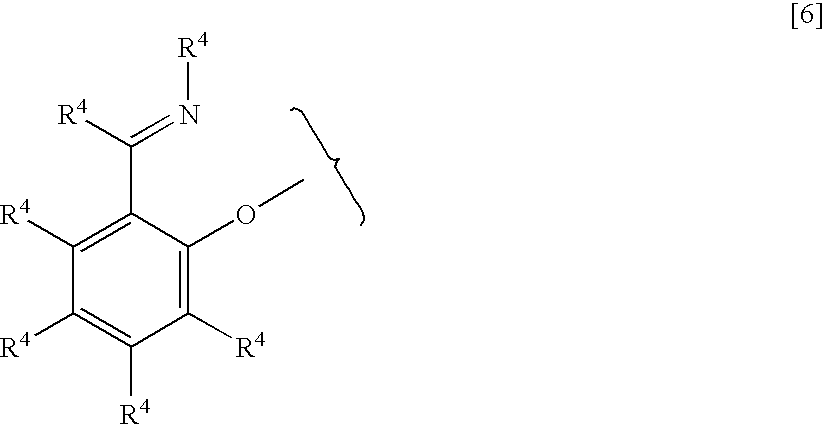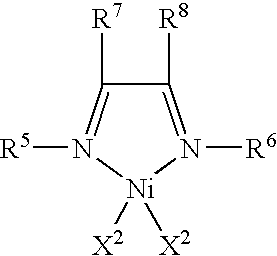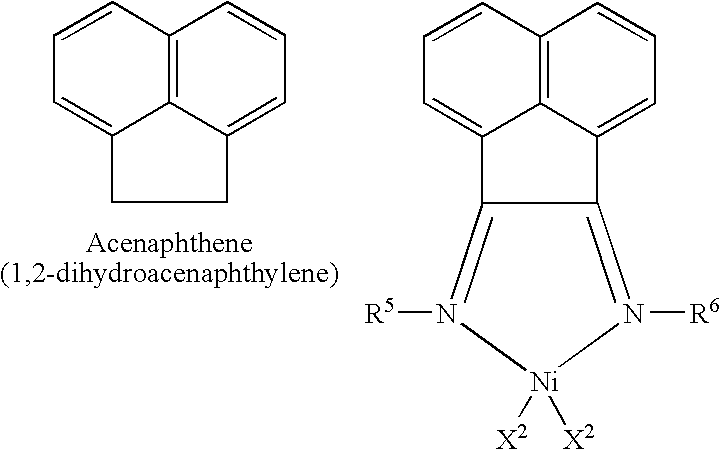Processes for producing a catalyst component for addition polymerization, a catalyst and an addition polymer
- Summary
- Abstract
- Description
- Claims
- Application Information
AI Technical Summary
Benefits of technology
Problems solved by technology
Method used
Image
Examples
example 1
(1) Preparation of Particles (d)
[0188]A reactor equipped with an agitator was purged with a nitrogen gas. There were put in the reactor (i) 382 mL of toluene (solvent) and (ii) 38.6 g of silica (SYLOPOL 948 manufactured by Davison Co., Ltd.) having an average particle diameter of 55 μm, a pore volume of 1.67 ml / g, and a specific surface area of 325 m2 / g, which silica had been previously heated at 300° C. under a nitrogen gas flow. The mixture was agitated, and then was cooled down to 5° C. A solution of 16.3 mL of 1,1,1,3,3,3-hexamethyldisilazane in 28.6 mL of toluene was added dropwise over 30 minutes to the cooled mixture maintained at 5° C. After completion of the dropwise addition, the mixture was agitated at 5° C. for 1 hour, and then at 95° C. for 3 hours. The resultant mixture was subjected to solid-liquid separation, and the separated solid was washed six times with each 331 mL of toluene. There was added 110 mL of toluene (hydrocarbon solvent) to the washed solid, and the m...
example 2
(1) Preparation of Catalyst Component for Addition Polymerization
[0197]Example 1 was repeated except that (i) the separable flask was changed to a tank-type glass separable flask having a diameter of 85.2 mm and a volume of 500 mL, and equipped with a pitched blade turbine (number of blades: four, diameter: 28.4 mm, rake: 45°), and two baffle plates, and (ii) the agitator power of 0.17 kW / m3 was changed to 0.40 kW / m3, thereby obtaining 73.7 g of a catalyst component for addition polymerization.
(2) Polymerization
[0198]Example 1 was repeated except that (i) the gas composition in the system was changed to 1.01% by mol of hydrogen and 2.70% by mol of 1-butene, and (ii) the catalyst component for addition polymerization was changed to 4.4 mg of the above-obtained catalyst component, thereby obtaining 81 g of an ethylene-1-butene copolymer. A polymerization activity per 1 mol of zirconium atoms contained in the transition metal compound used was 1.8×108 g / mol-Zr, and that per 1 g of the ...
example 3
(1) Preparation of Catalyst Component for Addition Polymerization
[0202]A tank-type separable flask having a diameter of 58 mm and a volume of 200 mL, and equipped with two finger-type baffle plates, and a Pfaudler type impeller having a diameter of 35 mm was purged with nitrogen gas. There were put in the flask (i) 70 mL of toluene (solvent) and (ii) 7.0 g of silica (SYLOPOL 948 manufactured by Davison Co., Ltd.) having an average particle diameter of 55 μm, a pore volume of 1.67 ml / g, and a specific surface area of 325 m2 / g, which silica had been previously heated at 300° C. under a nitrogen gas flow. The mixture was agitated under an agitator power of 0.77 kW / m3. The mixture was cooled down to 5° C. There was added dropwise over 20 minutes 19.1 mL of PMAO-S toluene solution (activation compound, aluminum concentration of 2.79 mol / L) manufactured by TOSOH FINECHEM CORPORATION to the cooled mixture maintained at 5° C. After the completion of the dropwise addition, the mixture was ag...
PUM
| Property | Measurement | Unit |
|---|---|---|
| Power density | aaaaa | aaaaa |
| Power density | aaaaa | aaaaa |
| Power | aaaaa | aaaaa |
Abstract
Description
Claims
Application Information
 Login to View More
Login to View More - R&D
- Intellectual Property
- Life Sciences
- Materials
- Tech Scout
- Unparalleled Data Quality
- Higher Quality Content
- 60% Fewer Hallucinations
Browse by: Latest US Patents, China's latest patents, Technical Efficacy Thesaurus, Application Domain, Technology Topic, Popular Technical Reports.
© 2025 PatSnap. All rights reserved.Legal|Privacy policy|Modern Slavery Act Transparency Statement|Sitemap|About US| Contact US: help@patsnap.com



